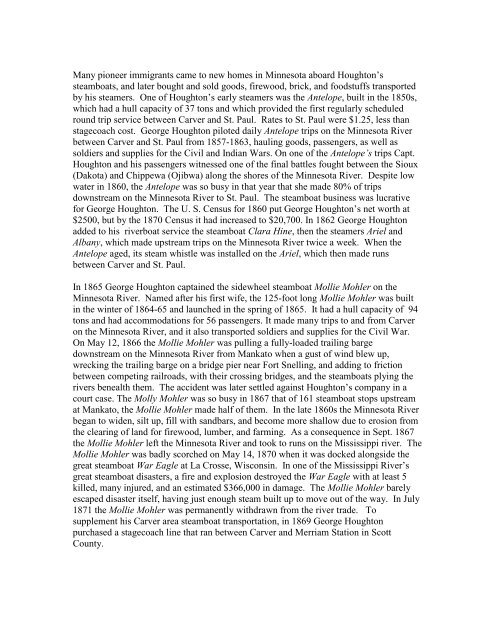Historic Homes and Businesses in Carver - Carver County Historical ...
Historic Homes and Businesses in Carver - Carver County Historical ...
Historic Homes and Businesses in Carver - Carver County Historical ...
Create successful ePaper yourself
Turn your PDF publications into a flip-book with our unique Google optimized e-Paper software.
Many pioneer immigrants came to new homes <strong>in</strong> M<strong>in</strong>nesota aboard Houghton‟s<br />
steamboats, <strong>and</strong> later bought <strong>and</strong> sold goods, firewood, brick, <strong>and</strong> foodstuffs transported<br />
by his steamers. One of Houghton‟s early steamers was the Antelope, built <strong>in</strong> the 1850s,<br />
which had a hull capacity of 37 tons <strong>and</strong> which provided the first regularly scheduled<br />
round trip service between <strong>Carver</strong> <strong>and</strong> St. Paul. Rates to St. Paul were $1.25, less than<br />
stagecoach cost. George Houghton piloted daily Antelope trips on the M<strong>in</strong>nesota River<br />
between <strong>Carver</strong> <strong>and</strong> St. Paul from 1857-1863, haul<strong>in</strong>g goods, passengers, as well as<br />
soldiers <strong>and</strong> supplies for the Civil <strong>and</strong> Indian Wars. On one of the Antelope’s trips Capt.<br />
Houghton <strong>and</strong> his passengers witnessed one of the f<strong>in</strong>al battles fought between the Sioux<br />
(Dakota) <strong>and</strong> Chippewa (Ojibwa) along the shores of the M<strong>in</strong>nesota River. Despite low<br />
water <strong>in</strong> 1860, the Antelope was so busy <strong>in</strong> that year that she made 80% of trips<br />
downstream on the M<strong>in</strong>nesota River to St. Paul. The steamboat bus<strong>in</strong>ess was lucrative<br />
for George Houghton. The U. S. Census for 1860 put George Houghton‟s net worth at<br />
$2500, but by the 1870 Census it had <strong>in</strong>creased to $20,700. In 1862 George Houghton<br />
added to his riverboat service the steamboat Clara H<strong>in</strong>e, then the steamers Ariel <strong>and</strong><br />
Albany, which made upstream trips on the M<strong>in</strong>nesota River twice a week. When the<br />
Antelope aged, its steam whistle was <strong>in</strong>stalled on the Ariel, which then made runs<br />
between <strong>Carver</strong> <strong>and</strong> St. Paul.<br />
In 1865 George Houghton capta<strong>in</strong>ed the sidewheel steamboat Mollie Mohler on the<br />
M<strong>in</strong>nesota River. Named after his first wife, the 125-foot long Mollie Mohler was built<br />
<strong>in</strong> the w<strong>in</strong>ter of 1864-65 <strong>and</strong> launched <strong>in</strong> the spr<strong>in</strong>g of 1865. It had a hull capacity of 94<br />
tons <strong>and</strong> had accommodations for 56 passengers. It made many trips to <strong>and</strong> from <strong>Carver</strong><br />
on the M<strong>in</strong>nesota River, <strong>and</strong> it also transported soldiers <strong>and</strong> supplies for the Civil War.<br />
On May 12, 1866 the Mollie Mohler was pull<strong>in</strong>g a fully-loaded trail<strong>in</strong>g barge<br />
downstream on the M<strong>in</strong>nesota River from Mankato when a gust of w<strong>in</strong>d blew up,<br />
wreck<strong>in</strong>g the trail<strong>in</strong>g barge on a bridge pier near Fort Snell<strong>in</strong>g, <strong>and</strong> add<strong>in</strong>g to friction<br />
between compet<strong>in</strong>g railroads, with their cross<strong>in</strong>g bridges, <strong>and</strong> the steamboats ply<strong>in</strong>g the<br />
rivers benealth them. The accident was later settled aga<strong>in</strong>st Houghton‟s company <strong>in</strong> a<br />
court case. The Molly Mohler was so busy <strong>in</strong> 1867 that of 161 steamboat stops upstream<br />
at Mankato, the Mollie Mohler made half of them. In the late 1860s the M<strong>in</strong>nesota River<br />
began to widen, silt up, fill with s<strong>and</strong>bars, <strong>and</strong> become more shallow due to erosion from<br />
the clear<strong>in</strong>g of l<strong>and</strong> for firewood, lumber, <strong>and</strong> farm<strong>in</strong>g. As a consequence <strong>in</strong> Sept. 1867<br />
the Mollie Mohler left the M<strong>in</strong>nesota River <strong>and</strong> took to runs on the Mississippi river. The<br />
Mollie Mohler was badly scorched on May 14, 1870 when it was docked alongside the<br />
great steamboat War Eagle at La Crosse, Wiscons<strong>in</strong>. In one of the Mississippi River‟s<br />
great steamboat disasters, a fire <strong>and</strong> explosion destroyed the War Eagle with at least 5<br />
killed, many <strong>in</strong>jured, <strong>and</strong> an estimated $366,000 <strong>in</strong> damage. The Mollie Mohler barely<br />
escaped disaster itself, hav<strong>in</strong>g just enough steam built up to move out of the way. In July<br />
1871 the Mollie Mohler was permanently withdrawn from the river trade. To<br />
supplement his <strong>Carver</strong> area steamboat transportation, <strong>in</strong> 1869 George Houghton<br />
purchased a stagecoach l<strong>in</strong>e that ran between <strong>Carver</strong> <strong>and</strong> Merriam Station <strong>in</strong> Scott<br />
<strong>County</strong>.


